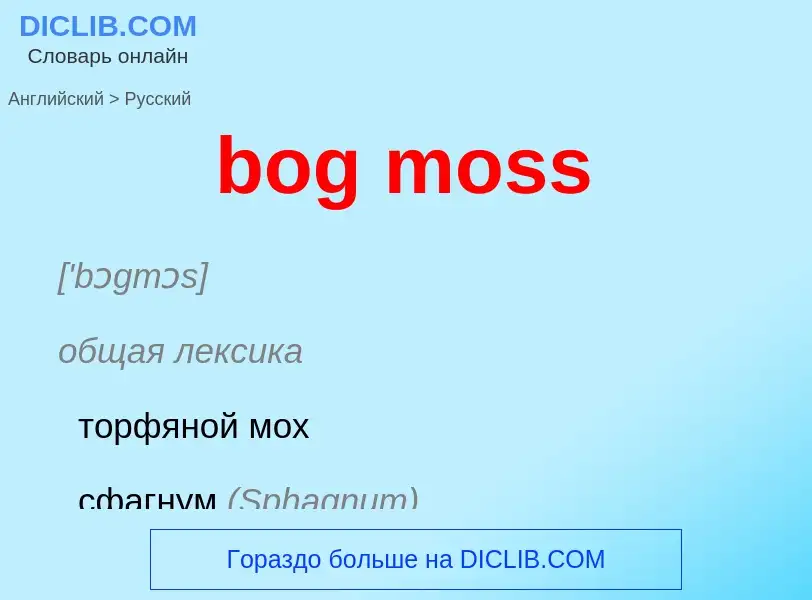Tradução e análise de palavras por inteligência artificial ChatGPT
Nesta página você pode obter uma análise detalhada de uma palavra ou frase, produzida usando a melhor tecnologia de inteligência artificial até o momento:
- como a palavra é usada
- frequência de uso
- é usado com mais frequência na fala oral ou escrita
- opções de tradução de palavras
- exemplos de uso (várias frases com tradução)
- etimologia
bog moss - tradução para russo
['bɔgmɔs]
общая лексика
торфяной мох
сфагнум (Sphagnum)
ботаника
белый болотный мох (Sphagnum)
белый болотный мох
Смотрите также
Definição
Wikipédia

Sphagnum is a genus of approximately 380 accepted species of mosses, commonly known as sphagnum moss, also bog moss and quacker moss (although that term is also sometimes used for peat). Accumulations of Sphagnum can store water, since both living and dead plants can hold large quantities of water inside their cells; plants may hold 16 to 26 times as much water as their dry weight, depending on the species. The empty cells help retain water in drier conditions.
As Sphagnum moss grows, it can slowly spread into drier conditions, forming larger mires, both raised bogs and blanket bogs. Thus, Sphagnum can influence the composition of such habitats, with some describing Sphagnum as 'habitat manipulators'. These peat accumulations then provide habitat for a wide array of peatland plants, including sedges and ericaceous shrubs, as well as orchids and carnivorous plants.
Sphagnum and the peat formed from it do not decay readily because of the phenolic compounds embedded in the moss's cell walls. In addition, bogs, like all wetlands, develop anaerobic soil conditions, which produces slower anaerobic decay rather than aerobic microbial action. Peat moss can also acidify its surroundings by taking up cations, such as calcium and magnesium, and releasing hydrogen ions.
Under the right conditions, peat can accumulate to a depth of many meters. Different species of Sphagnum have different tolerance limits for flooding and pH, and any one peatland may have a number of different Sphagnum species.


![Sphagnum moss wound dressings being made at the [[University of Toronto]] c. 1914 Sphagnum moss wound dressings being made at the [[University of Toronto]] c. 1914](https://commons.wikimedia.org/wiki/Special:FilePath/Making sphagnum moss dressings, University of Toronto.jpg?width=200)
![[[Mer Bleue Conservation Area]], a large, protected ''Sphagnum'' bog near Ottawa, Ontario, Canada [[Mer Bleue Conservation Area]], a large, protected ''Sphagnum'' bog near Ottawa, Ontario, Canada](https://commons.wikimedia.org/wiki/Special:FilePath/MerBleueBog.jpg?width=200)

![''Sphagnum'' with northern pitcher plants (''[[Sarracenia purpurea]]'') at [[Brown's Lake Bog]], [[Ohio]] ''Sphagnum'' with northern pitcher plants (''[[Sarracenia purpurea]]'') at [[Brown's Lake Bog]], [[Ohio]]](https://commons.wikimedia.org/wiki/Special:FilePath/Sphagnum Brown's Lake Bog.jpg?width=200)


